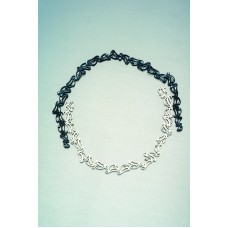PlatAfrica 2017
Bold minimalism takes
center stage at PlatAfrica 2017
Update 2: PlatAfrica is in its 19th year and is South Africa’s premier platinum jewellery competition. This year we again saw some exceptional design pieces that highlighted the unique properties of platinum.. With PGI’s encouragement and support, the winners got the opportunity to attend design workshops in Mumbai, developing their talent and broadening their horizons to think about designs for the global markets. We truly value this partnership with PGI which is now in its 2nd year.
Here are the winning pieces from PlatAfrica 2017 and the inspiration behind these pieces:
1: The family bond by Ulandie Jonas(1st in professional category):
The inspiration of the elegant neckpiece comes from the Indian tradition of the bridal mehndi ceremony that signifies the bond of marriage & family. The piece comes together beautifully to represent the bond of a couple, family, traditions in a simplistic yet subtle way. The structure of the neckpiece displays the strength of platinum in this intricate design.
“To guide my design process, I kept in mind the statement “less is more”by an industrial designer describing minimalism. I decided to design a neckpiece for the modern Indian bride, keeping the traditional wedding in mind but giving it a modern twist. The Mehendi ceremony became the source of my inspiration, as it signifies the bond of marriage and family.
The organic curved lines resemble the Mehendi and the two contracting colours represent the union of both the couple and their families. The polished platinum represents a modern take on traditions while the black represents old traditional ways. The pearl symbolises union, purity and love which is celebrated on one’s wedding day.”
2: Indian Amulet by Nihal Shah (2nd in the professional category):
The bracelet is a modern take of Indian amulet and the inspiration comes from the modern trend of men accessorising themselves with watches and bracelets. The element in the centre is a contemporary take on Lord Ganesha.
In India Lord Ganesha is considered auspicious and symbolic of new beginnings and special occasions like weddings, birth of a new child, etc. Interestingly the elephant is also an integral part of the South African culture. This piece is remarkable representation of how two separate continents are bridged by this one icon.
“Being a male Indian Millennial, I remain connected with my culture and traditions which brought about the idea to incorporate the current trends of the modern world with age-old traditions. I noticed a trend for men to wear their watches and bracelets side by side that sparked the idea to create a men’s bracelet. This bracelet is a modern take on an Indian amulet.
The element in the centre is a contemporary take on Lord Ganesha. Keeping the design hooks in mind, I created a sculpted feel of the Ganesha, where I was able to showcase the strength of platinum. I have also incorporated Rudraksh beads that offer protection to the wearer from negative energies. Additionally, the red base metal adds an antique feel and signifies sensuality and purity of the Indian community.”
3: Undulation Byanke Van Der Linden (1st in student & apprentice category):
The inspiration for this 3 dimensional & double coiled ring comes from spiral earrings by Agata Krzyzanowska and the spiral shape roof of Audemars Piguets headquarters in Switzerland. This lightweight sculptural ring will impress both the viewer and wearer at any occasion.
“The bold minimalism and clean lines of modern architecture combined with curiosity and experimentation aided the development and design of my sculptural statement ring. My process began by piercing multiple slits into a long, thin sheet of metal and manipulating it to create a coiled three-dimensional form.
To add extra dimension and emphasis, a smaller coil in an opposing direction was placed inside the larger coil. Combining these multi-dimensional coils is an elegant cross-over band. The statement ring when viewed from different angles creates an ‘optical illusion’.”
4: Forgotten Triumphs by Fraser Schenck (2nd in the student & apprentice category):
The inspiration of the neckpiece Forgotten Triumphs comes from The Hall of Nation building that was constructed in 1972 as a part of an exhibition complex at Pragati Maidan in New Delhi. It stood as a landmark of Indian triumph and a symbol of India’s independence.
“The neckpiece pays homage to the Hall of Nations building and stands as a reminder to India’s younger generation to not forget their heritage and the accomplishments of their fathers but to celebrate their legacy. The design of the neckpiece incorporates many features that was inspired by the building itself such as the use of triangles, negative spaced triangles and most importantly the use of concrete that refers to the concrete features of the building”.




